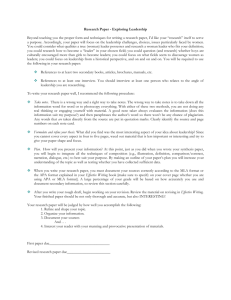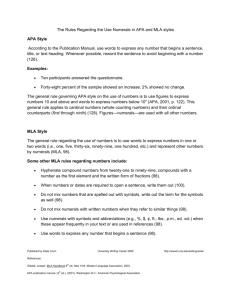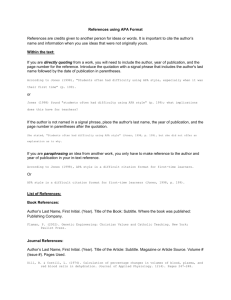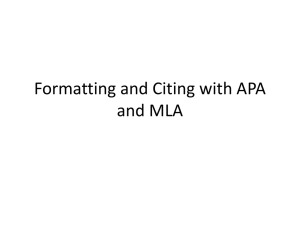General Format
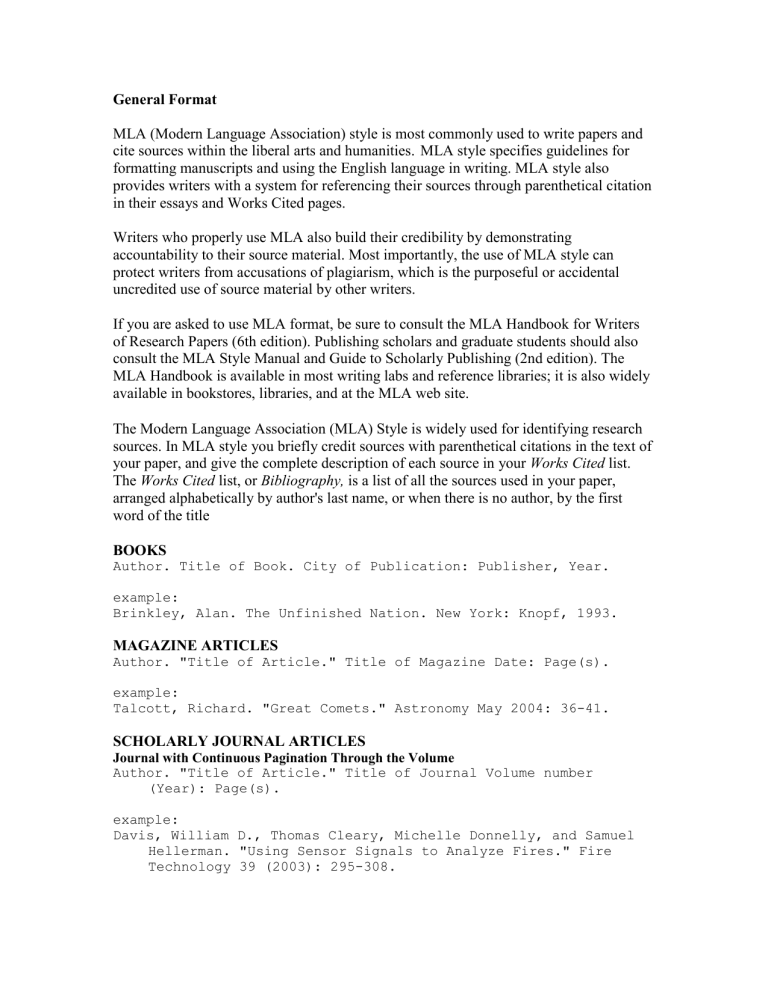
General Format
MLA (Modern Language Association) style is most commonly used to write papers and cite sources within the liberal arts and humanities.
MLA style specifies guidelines for formatting manuscripts and using the English language in writing. MLA style also provides writers with a system for referencing their sources through parenthetical citation in their essays and Works Cited pages.
Writers who properly use MLA also build their credibility by demonstrating accountability to their source material. Most importantly, the use of MLA style can protect writers from accusations of plagiarism, which is the purposeful or accidental uncredited use of source material by other writers.
If you are asked to use MLA format, be sure to consult the MLA Handbook for Writers of Research Papers (6th edition). Publishing scholars and graduate students should also consult the MLA Style Manual and Guide to Scholarly Publishing (2nd edition). The
MLA Handbook is available in most writing labs and reference libraries; it is also widely available in bookstores, libraries, and at the MLA web site.
The Modern Language Association (MLA) Style is widely used for identifying research sources. In MLA style you briefly credit sources with parenthetical citations in the text of your paper, and give the complete description of each source in your Works Cited list.
The Works Cited list, or Bibliography, is a list of all the sources used in your paper, arranged alphabetically by author's last name, or when there is no author, by the first word of the title
BOOKS
Author. Title of Book. City of Publication: Publisher, Year. example:
Brinkley, Alan. The Unfinished Nation. New York: Knopf, 1993.
MAGAZINE ARTICLES
Author. "Title of Article." Title of Magazine Date: Page(s). example:
Talcott, Richard. "Great Comets." Astronomy May 2004: 36-41.
SCHOLARLY JOURNAL ARTICLES
Journal with Continuous Pagination Through the Volume
Author. "Title of Article." Title of Journal Volume number
(Year): Page(s). example:
Davis, William D., Thomas Cleary, Michelle Donnelly, and Samuel
Hellerman. "Using Sensor Signals to Analyze Fires." Fire
Technology 39 (2003): 295-308.
Journal with Issues Paged Separately
Author. "Title of Article." Title of Journal Volume number. Issue number (Year): Page(s).
▪ Give both the volume and issue numbers, separated by a period: volume 12, no. 8 = 12.8
Murphy, Karen L., Roseanne DePasquale, and Erin McNamara.
"Meaningful Connections: Using Technology in Primary
Classrooms." Young Children 58.6 (2003): 12-18.
NEWSPAPER ARTICLES
Author. "Title of Article." Name of Newspaper Date, edition:
Page(s).
* Take the name of the newspaper from the masthead, but omit any introductory article: Honolulu
Advertiser, not The Honolulu Advertiser.
*If the city of publication is not part of the newspaper's name, add it in square brackets: News and
Observer [Raleigh, NC]
*Give the complete date, but not the volume and issue numbers.
*Specify the edition of the newspaper, if one is given on the masthead.
*If the article is not on consecutive pages, write the first page number and a plus sign: B1+.
Daranciang, Nelson. "Sex Offender Web Site Debated." Honolulu
Star-Bulletin 8 Apr. 2004, night final ed.: A3.
WEB SITES
▪ Complete publication information may not be available for a Web site; provide what is given.
Entire Internet Site: Scholarly Project or Professional Site
Title of the Site. Editor. Date and/or Version Number. Name of
Sponsoring Institution. Date of Access <URL>.
Encyclopedia Mythica. 2004.13 May 2004<http://www.pantheon.org/>.
Document from a Web Site
Author. "Title of Web Page." Title of the Site. Editor. Date and/or Version Number. Name of Sponsoring Institution. Date of Access <URL>.
Sherman, Chris. "Everything You Ever Wanted to Know About URL."
SearchEngineWatch. Ed. Danny Sullivan. 24 Aug. 2004. 4 Sept.
2004<http://searchenginewatch.com/searchday/article.php/33985
11>.
APA (American Psychological Association) is most commonly used to cite sources within the social sciences. When editors or teachers ask you to write in "APA style," they do not mean writing style. They are referring to the editorial style that many of the social and behavioral sciences have adopted to present written material in the field.
The American Psychological Association has established a style that it uses in all of the books and journals that it publishes. Many others working in the social and behavioral sciences have adopted this style as their standard as well. This resource, revised according to the 5th edition of the APA manual, offers examples for the general format of APA research papers, in-text citations, endnotes/footnotes, and the reference page.
Short Quotations
If you are directly quoting from a work, you will need to include the author, year of publication, and the page number for the reference (preceded by "p."). Introduce the quotation with a signal phrase that includes the author's last name followed by the date of publication in parentheses.
According to Jones (1998), "Students often had difficulty using APA style, especially when it was their first time" (p. 199).
Jones (1998) found "students often had difficulty using APA style" (p. 199); what implications does this have for teachers?
If the author is not named in a signal phrase, place the author's last name, the year of publication, and the page number in parentheses after the quotation.
She stated, "Students often had difficulty using APA style," (Jones, 1998, p. 199), but she did not offer an explanation as to why.
Long Quotations
Place direct quotations longer than 40 words in a free-standing block of typewritten lines, and omit quotation marks. Start the quotation on a new line, indented five spaces from the left margin. Type the entire quotation on the new margin, and indent the first line of any subsequent paragraph within the quotation five spaces from the new margin.
Maintain double-spacing throughout. The parenthetical citation should come after closing punctuation mark.
Jones's (1998) study found the following:
Students often had difficulty using APA style, especially when it was their first time citing sources. This difficulty could be attributed to the fact that many students failed to purchase a style manual or to ask their teacher for help. (p. 199)
Summary or Paraphrase
If you are paraphrasing an idea from another work, you only have to make reference to the author and year of publication in your in-text reference, but APA guidelines encourage you to also provide the page number (although it is not required.)
According to Jones (1998), APA style is a difficult citation format for first-time learners.
APA style is a difficult citation format for first-time learners (Jones, 1998, p. 199).
Reference List: Basic Rules
Your reference list should appear at the end of your paper. It provides the information necessary for a reader to locate and retrieve any source you cite in the body of the paper.
Each source you cite in the paper must appear in your reference list; likewise, each entry in the reference list must be cited in your text.
Your references should begin on a new page separate from the text of the essay; label this page References (with no quotation marks, underlining, etc.), centered at the top of the page. It should be double-spaced just like the rest of your essay.
Basic Rules
• All lines after the first line of each entry in your reference list should be indented onehalf inch from the left margin. This is called hanging indentation.
• Authors' names are inverted (last name first); give the last name and initials for all authors of a particular work unless the work has more than six authors. If the work has more than six authors, list the first six authors and then use et al. after the sixth author's name to indicate the rest of the authors.
• Reference list entries should be alphabetized by the last name of the first author of each work.
• If you have more than one article by the same author, single-author references or multiple-author references with the exact same authors in the exact same order are listed in order by the year of publication, starting with the earliest.
• When referring to any work that is NOT a journal, such as a book, article, or Web page, capitalize only the first letter of the first word of a title and subtitle, the first word after a colon or a dash in the title, and proper nouns. Do not capitalize the first letter of the second word in a hyphenated compound word.
• Capitalize all major words in journal titles.
• Italicize titles of longer works such as books and journals.
• Do not italicize, underline, or put quotes around the titles of shorter works such as journal articles or essays in edited collections.
